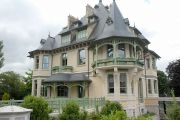Discover what makes the Champagne wine region unique. Vineyards rolling over hillsides, cellars dug into former chalk quarries and the gorgeous buildings of the Champagne houses.
[ Practical ]
Getting there
- By road
145 km from Paris to Reims on autoroute A4
148 km from Paris to Epernay on autoroute A4 till exit 21, then on D23 and D3 till Epernay.
30 km from Reims to Epernay on N51, D301 and D40.
- By train
TGV from Paris Gare de l’Est to Reims. The journey takes 46 mn.
TER train from Paris Gare de l’Est to Epernay. The journey takes 1 h 10 mn.
Lodging
- Reims
Château Les Crayères
Hôtel de la Paix
Le Voluptine
Mercure Centre
- Epernay
Hôtel Jean Moet
La Villa Eugène
Comfort Suites
- Aÿ
Champagne Domaine Sacret
- Châlons-en-Champagne
Hôtel Le Renard
Restaurants
Café du Palais, in Reims
Racine in Reims
Le Foch in Reims
L’Alambic in Reims
- Epernay
La Cave à Champagne
Le Chapon Fin
L’Oeil de Bœuf
La Table Kobus
- Châlons-en-Champagne
Au Carillon Gourmand
Going out
Cité du Champagne Collet Cogevi
14 bld Pasteur, 51160 Aÿ
Rates : €15 to €40 per person
Tel : 0326559888
www.citeduchampagnecolletcogevi.com
Pommery
5 place Général Gouraud, 51100 Reims
Rates : €20 to €30 per person
Tel : 0326616256
www.champagnepommery.com
Taittinger
9 rue Saint-Nicaise, 51100 Reims
Rates : €17 to €45 per person.
Tel : 0326858433
www.taittinger.com
Moët & Chandon
20 avenue de Champagne, 51200 Epernay
Rates : €23 to €35 per person
Tel : 0326512020
fr.moet.com
Information
- Marne Tourist Office
Tel : 0326684645
www.tourisme-en-champagne.com
- Reims Tourist Office
Tel : 0326774500
www.reims-tourisme.com
- Epernay Tourist Office
Tel : 0326533300
www.ot-epernay.fr
- Champagne-Ardenne Tourist Office
Tel : 0326218580
www.tourisme-champagne-ardenne.com
Champagne hillsides, houses and cellars. Inseparable from the history and production of the world most famous wine, this triptych was inscribed on the UNESCO World Heritage list on July 4, 2015 in the Cultural Landscapes category.
This decision reflects the recognition of the uniqueness of the Champagne wine world that offers visitors hillsides planted with vines, the architecture of Champagne houses and hundreds of kilometres of cellars where bottles are aging.
 Along the Marne valley Along the Marne valley
Hillsides can be discovered on foot, bike, car or boat all along the Marne Valley between Château-Thierry and Epernay with a particularly spectacular section around Ay. Just 5 km from Epernay, this terroir is highly sought after because it is the only one classified as Grand Cru for the three main grape varieties used to produce Champagne: Pinot Noir, Pinot Meunier and Chardonnay.
Two villages provide unmatched panoramic views over these hillsides. Mutigny, located at an altitude of 240 meters, the highest point of the vineyard, from where you can see church steeples from 45 villages of the Marne Valley, the Montagne de Reims and the Côte des Blancs. In addition, a 2.2 kilometres long trail called “Sentier du Vigneron” threads through the vineyards and is marked with explanatory panels providing information on the various steps of the Champagne production process, from vine cultivation and the diseases threatening grapes to the economic weight of the sector.
 Birthplace of Champagne Birthplace of Champagne
The second one is Hautvilliers regarded as the birthplace of Champagne because it is here that its making process is said to have been developed by Dom Perignon in the 17th century. Considered one of the fathers of oenology, this Benedictine monk is buried in the church of the former abbey where he lived and worked. The village is also famous for its 140 wrought iron signs adorning most houses and symbolizing the activity of each building’s occupant, Champagne production being of course the predominant theme.
From there, it’s only 7 kilometres to get to Epernay where the aptly named Avenue de Champagne is lined with the headquarters of fourteen famous Champagne houses. Built during the 19th century in Renaissance or Classical style, these mansions stand over a 100 kilometres long underground labyrinth of chalky cellars. Let’s name Moët et Chandon, the world’s largest Champagne producer, that boasts 28 kilometres of tunnels containing 90 millions of bottles.

 Villa Demoiselle © T. Joly Villa Demoiselle © T. Joly
|
 Art Deco villas Art Deco villas
Pol Roger, that was the exclusive supplier of Winston Churchill. Mercier, where a section of the 18 kilometres long cellar is visited in a laser-guided train. Also worth to see is the Château Perrier, former home of Perrier- Jouet’s owners, built in 1854 in Renaissance style, which was successively the headquarters of the British, German and U.S armies during WWII.
The architectural heritage linked to Champagne also comprises the beautiful Art Deco Villa Collet, in the nearby small town of Ay. Built in 1921, recently restored and furnished accordingly, it is the property of the cooperative Cogevi - Champagne Collet that also has a museum where are displayed various winemakers and winegrowers materials and tools from the early 20th century. Another building worth a look is the Villa Demoiselle, in Reims, an elegant mix of Art Nouveau and Art Deco styles.

 Taittinger's cellars © T. Joly Taittinger's cellars © T. Joly
|
 Underground cathedrals Underground cathedrals
Today, it is owned by Vranken Pommery house whose cellar is next door and holds one of world largest barrels with a capacity of 75,000 litres. It is decorated with sculptures by Art Nouveau artist Emile Gallé and was created for the 1904 World’s Fair in Saint Louis, Missouri, to illustrate the friendship between France and America. 30 meters below, lie the 19th century 18 km long company's cellars dug in former Gallo-Roman chalk quarries. As beautiful if not more, the cellars of Taittinger extend under the Saint-Nicaise hill. They occupy part of the former cellars of the eponymous abbey founded in the 13th century as well as almost untouched Gallo-Roman chalk pits, some of them so vast that you get the feeling to be in true underground cathedrals.
August 26, 2016
Thierry Joly 

|



